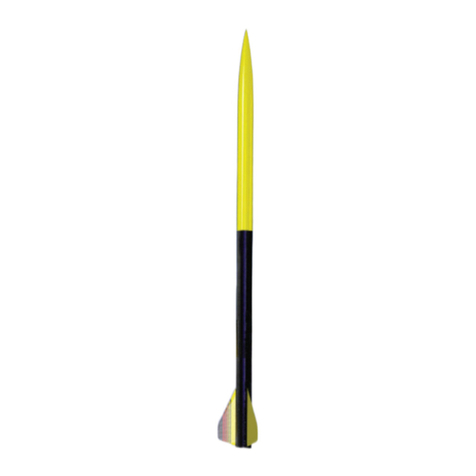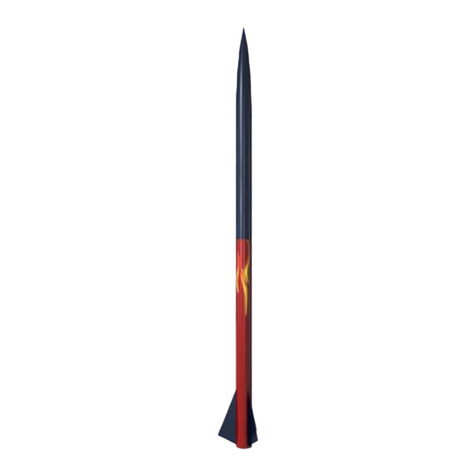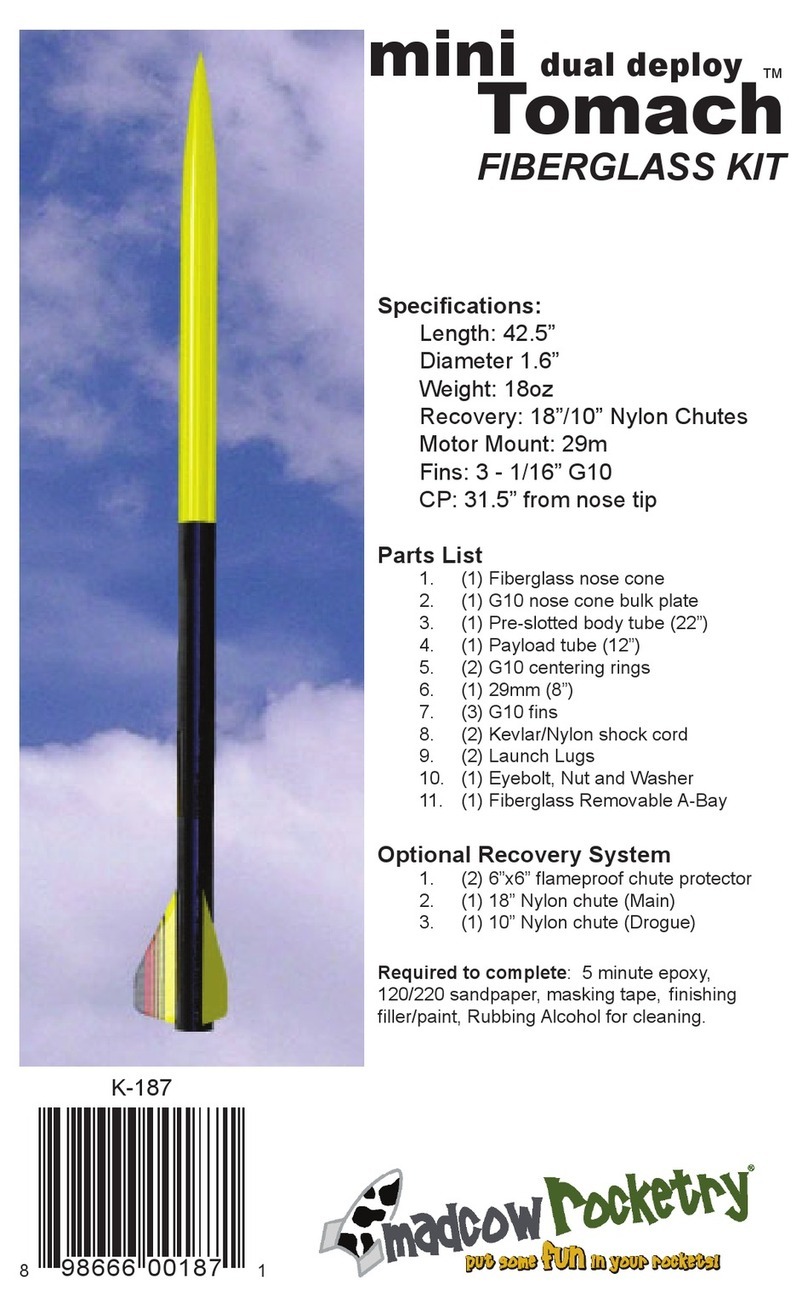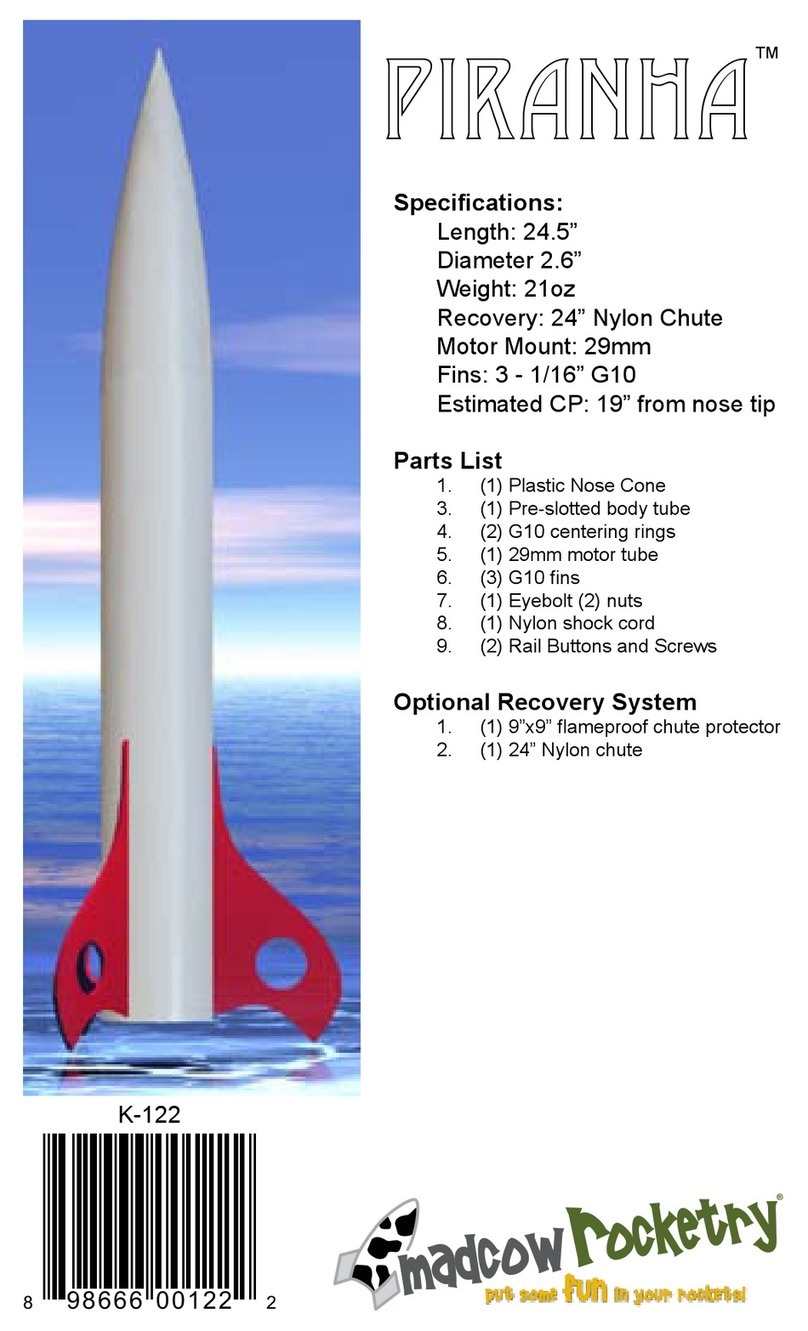
2 ©2014 MadCow Rocketry™ FG Tomach™ Assembly FG Tomach™ Assembly ©2014 MadCow Rocketry™ 3
Please make sure you read all directions and understand how to assemble your model
beforeyoustartconstruction.Itisalsoagoodideatotestteachpartbeforeassembly.
Fiberglass parts still contain small amounts of mold release and other materials on the
surface that will inhibit adhesives and/or paint. It is important to clean each part prior
to assembly with a solution of 1 part rubbing alcohol, 3 parts water and a drop of dish
washing soap. IMPORTANT: do not sand any parts until after you have cleaned them -
youwillembedthematerialsyouaretryingtocleanmakingitdifculttoclean.
The G10 parts will have holding tabs left over from the CNC machine. These small tabs
will need to be sanded off before assembly. Before assembling any part with epoxy,
rough up the surface to be epoxied using course sandpaper. The scratches in the G10
surface will give the epoxy something to grab onto.
Step 1 – Motor Mount Assembly
Testtthecenteringringsoverthemotormounttubeandsandifnecessary.Alsotest
tthecenteringringsinthebodytubeandsandifnecessary.Theringwiththe1/4”hole
for an eyebolt will be the forward ring (38mm version only). Spread some epoxy on the
outside of one end of the motor tube and slide the ring (without the hole) until there is
approximately 1/2” of motor tube exposed. Make sure you clean the motor tube of any
epoxysoasnottointerferewiththentangslater.Aftertheaftringisdry,makeamark
1” from the other end of the motor tube. Spread some epoxy on the motor tube and
slide the forward ring until it aligns with the mark. VERY IMPORTANT: make sure there
is not any epoxy on the motor tube that would interfere with the n tangs later
on. Also test t one of the ns to make sure there is enough room for the n tang
between the centering rings.
38mm Version: Mount the eyebolt
using the two nuts as shown in the
forward ring hole. Apply some epoxy
to the nuts to ensure they will not
come loose later. Attach one end of
the shock cord to the eyebolt using
an overhand knot. IMPORTANT:
Make sure the eyebolt and nut
are aligned properly so the motor
assembly can slide into the body
tube.
54mm Version: Use the motor’s
forward closure retention eyebolt for the recovery attachment point.
Step 4 – Rail Button Attachment
Drill a 5/64” hole on the rail button line for the forward and aft rail buttons. The aft hole
should be 1/2” from the aft end of the aft body tube and the forward hole should be near
the center of pressure (CP). Apply a small amount of epoxy in the holes and attach the
rail buttons using the supplied #6 wood screws. Make sure the screw is loose enough
for the rail button to spin freely - this ensures the button is not compressed to the point it
will hang on the rail guide.
IMPORTANT: Make sure the forward rail button screw protruding through the body
tube doesn’t snag the chute. Epoxy over the screw to provide a smooth surface.
The screw can also be cut shorter.
Step 2 – Insert Motor Tube Assembly into Body Tube
Wrap the shock chord into a small bundle and stuff it inside the motor tube for this next
step.Testtthemotortubeassemblyintothebodytubetoensureasnugt.Sandthe
centeringringsifnecessary.Whenyouaresatisedwiththet,spreadsomeepoxyon
the inside of the body tube and slide the forward centering ring of the motor assembly
into the body tube. Make sure you have the motor assembly facing the right way!
(38mm version only) Spread some more epoxy
on the inside edge of the body tube before
sliding the rear centering ring into the body tube.
Continue sliding the assembly inside the body
tube until the aft end of the motor tube is even
with the aft end of the body tube. It’s a good
ideatotesttanineachslotherebeforethe
epoxy sets. Hold the body tube with the motor
tube assembly down until the epoxy sets. Make sure the weight of the motor assembly
doesn’t cause it to slide out of alignment.
Step 3 – Fin Assembly
Using a door jam or small section of angle stock, pencil a line halfway between two of
thensthatextendsfromthefronttothebackofthebodytube.Thislinewillbeused
latertoaligntherailbuttons.Testteachofthensintotheprecutnslots.Then
shouldseatrmlyagainstthemotortube-sandeachnifnecessary.Whenyouare
satisedwiththet,applysomeepoxytotheendofthentangthatwillcontactthe
motortube.Also,spreadathinlayerofepoxyoneachsideofthentang.Slidethen
intoplaceandcheckthealignment.Continuerecheckingthenalignmentuntilyouare
suretheepoxyhasset.Cleananyexcessepoxyfromaroundthenjoint.Repeatfor
theremainingns.Next,applyepoxylletstobothsidesofeachnbyapplyingathin
beadofepoxyatthen-bodytubejoing.Carefullysmooththeepoxylletswithyour
ngerbeforetheepoxysets.Alloweachllettosetbeforerotatingtheairframeforthe
nextllet.
Step 6 – Balance and Nose Cone Assembly
Epoxy the shorter coupler into the nose cone. Insert the nose cone and coupler into
the forward body tube to make sure the coupler is aligned properly. BE CAREFUL not
to glue the nose cone to the body tube. Mount the remaining eyebolt using the nut and
washer in the nose cone bulkplate. Apply some epoxy to the nut so it will not come loose
later.Testtthebulkplateinthebaseofthenoseconeandsandifnecessary,butdon’t
glue it in yet.
At this point, pack the chute and assemble the rocket. Assemble your model and insert
thelargestmotoryouintendtoy(orsimulatetheweightwithasubstitute)andensure
thattheCGisatleast1bodydiameterinfrontoftheestimatedCPpointspeciedonthe
rstpage.TheCPpointismeasuredfromthetipofthenosecone.IftheCGisbehind
the desired point, add weight inside the nose cone by pouring lead shot into the nose
cone tip and adding some epoxy.
Whenyouaresatisiedwiththebalanceoftherocket,epoxythebulkplateintothebase
ofthenoseconeleavingatleasta1/4”liptoapplyallet.Next,applyalletofepoxy
around the bulkplate and nose cone shoulder joint.
1/2” Exposed
1” Exposed
Forward Ring Hole
Fin Tang
Step 5 – Altimeter Bay Assembly
Refer to the Fiberglass Removable Altimeter Bay instructions and assemble the altimeter
bay.
Ensureringsareclearofthenslots












































